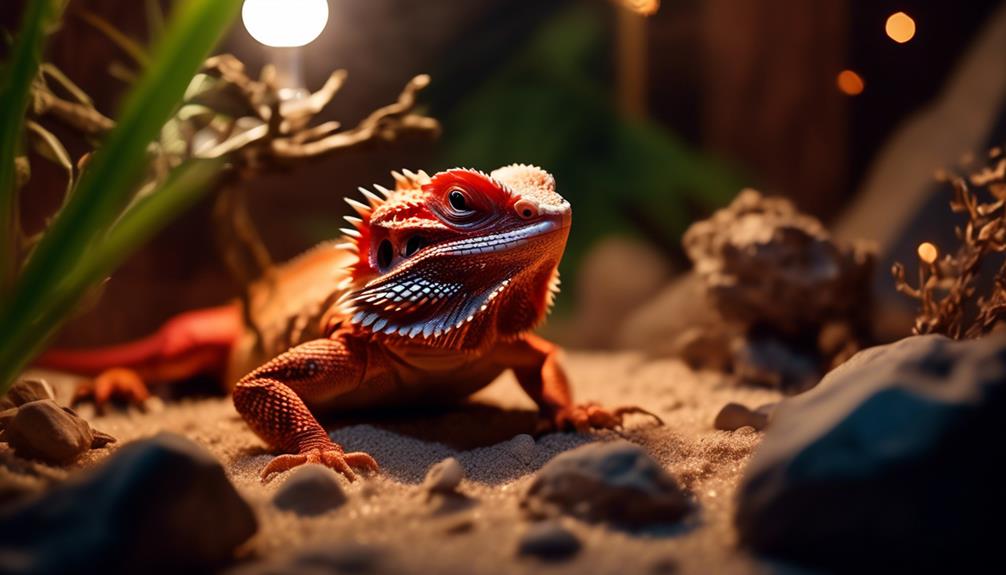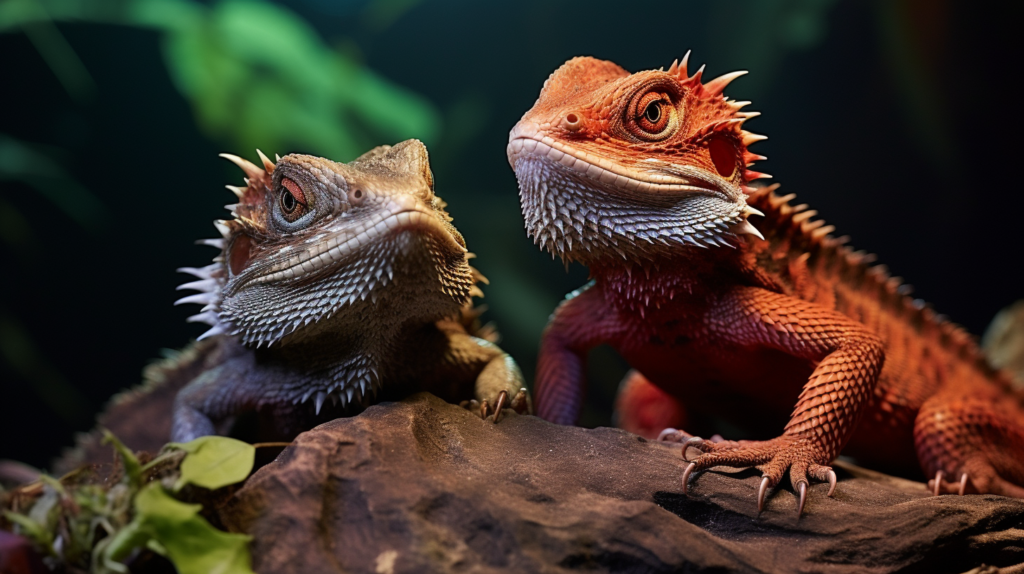Imagine owning a pet that embodies the fiery hues of a sunset, with scales that shimmer like molten lava. The Red Leatherback Bearded Dragon is a captivating creature that demands specific care to thrive in captivity.
From creating the perfect habitat to understanding their unique dietary needs, caring for these dragons requires attention to detail and a deep understanding of their natural behaviors.
As you embark on the journey of caring for a Red Leatherback Bearded Dragon, you'll discover the intricacies of providing for this remarkable creature and forming a bond that goes beyond the ordinary.
Red Leatherback Bearded Dragon: Characteristics and Morphs
Red leatherback bearded dragons, distinguished by their smooth, scaleless backs, exhibit a striking range of colors from deep, fiery red to more subdued orange-red hues. These dragons are a genetic morph of the bearded dragon species and are highly valued for their vibrant and striking appearance. The smooth skin of the red leatherback bearded dragon sets them apart from other morphs, giving them an almost glossy appearance that intensifies their shades of red.
It's essential to understand the various genetic morphs that exist within the red leatherback bearded dragon community. One such morph is the hypo leatherback, which displays a lighter and more pastel-like red coloration. This morph variation is equally sought after, offering a unique and captivating aesthetic.
While the red leatherback bearded dragons are adored for their stunning appearance, it's crucial to be mindful of potential health issues. As with any reptile, they're susceptible to reptile diseases and illnesses. Regular veterinary check-ups, a proper diet, and a well-maintained habitat are essential in ensuring their well-being.
In caring for the red leatherback bearded dragon, understanding their genetic morphs and the various shades of red they can exhibit is fundamental. By recognizing their unique characteristics and potential health concerns, you can provide the best care for these captivating creatures.
Setting Up the Perfect Habitat
After understanding the various genetic morphs and potential health concerns of red leatherback bearded dragons, the next step is to create the optimal habitat for these captivating creatures. Setting up the perfect habitat for a red leatherback bearded dragon is crucial for its overall well-being. The following table outlines the essential elements needed for a red leatherback bearded dragon's habitat:
| Aspect | Description |
|---|---|
| Heating & Lighting | Maintain temperature and humidity using heating pads, lamps, or ceramic heat emitters and provide UVB lighting for calcium absorption. |
| Water Bowl | Include a large, shallow water bowl for drinking and soaking. Ensure it is accessible but not large enough to cause excessive humidity. |
| Substrate | Consider using orchid bark or other suitable substrates to create a natural environment, avoiding substrates that may lead to metabolic bone disease. |
To ensure the perfect habitat, it's essential to provide the right temperature and lighting conditions. Heating pads, lamps, or ceramic heat emitters should be utilized to maintain the required temperature, while UVB lighting is crucial for calcium absorption to prevent metabolic bone disease. Additionally, include a large, shallow water bowl for drinking and soaking, ensuring it's easily accessible but not large enough to cause excessive humidity. Lastly, opt for substrates like orchid bark to create a natural environment, avoiding substrates that may lead to metabolic bone disease. Creating the perfect habitat for your red leatherback bearded dragon is an essential part of responsible pet care.
Feeding and Nutrition Requirements
To meet the specific dietary needs of red leatherback bearded dragons, it's essential to carefully consider their feeding and nutrition requirements. When it comes to feeding your bearded dragon, it's crucial to provide a balanced diet to ensure their overall health and well-being. Here are some important guidelines to consider:
- Adults require a diet consisting of 80% vegetable matter and 20% live food. It's essential to include a variety of dark, leafy greens such as collard greens, mustard greens, and dandelion greens in their vegetable intake.
- For baby bearded dragons, their diet should consist of 80% live food and 20% vegetables. Small insects like appropriately sized crickets and roaches are ideal for their live food intake.
- While fruits are important for bearded dragons, they aren't as essential as vegetables and live food. Fruits can be offered as occasional treats and shouldn't be a primary component of their diet.
- When it comes to live food options, Dubia roaches and crickets are healthy choices for bearded dragons. These insects provide essential nutrients and are a preferred option compared to high-fat content foods like waxworms, which should be avoided. It's important to limit the intake of mealworms due to their high chitin content, which can be difficult for bearded dragons to digest.
Handling and Interacting With Your Dragon
When handling your red leatherback bearded dragon, it's important to approach with gentle and supportive movements to foster trust and minimize stress. Bearded dragons are delicate creatures, and proper handling is crucial for their well-being. Supporting the body and allowing the reptile to feel secure in your hands will help build a positive association with human interaction. Spend regular, consistent time with your leatherback bearded dragon to acclimate it to your presence. Allowing your dragon to climb on you and explore new environments under supervision is an excellent way to bond and provide enrichment. It's essential to respect your dragon's body language and mood during interactions to avoid unnecessary stress or aggression. Pay attention to cues such as puffing up, color changes, or tail movements, which can indicate discomfort or agitation.
Incorporating positive experiences like hand-feeding can further strengthen the bond with your red leatherback bearded dragon. This not only encourages trust but also provides mental stimulation and a positive association with human interaction. Additionally, spending time with your dragon in a calm and quiet environment can help reduce stress and promote a sense of security. By being attentive to your dragon's needs and preferences, you can create a harmonious and fulfilling interaction that benefits both you and your fiery pet.
Health Maintenance and Common Issues
As you maintain the health of your red leatherback bearded dragon, it's crucial to regularly monitor and maintain the temperature and humidity levels in the enclosure to prevent respiratory issues and stress. This is essential as bearded dragons are susceptible to respiratory problems when exposed to improper temperatures and humidity levels.
Additionally, here are some key points to consider for the health maintenance of your fiery pet:
- Provide a balanced diet of live food, vegetables, and occasional fruit to ensure nutritional needs are met and prevent obesity.
- Watch for signs of metabolic bone disease (MBD) such as bone deformities, tremors, and weakness, and ensure proper UVB lighting and calcium supplementation to prevent and manage MBD.
- Be alert for signs of constipation and impaction, and adjust the diet and provide warm baths if needed, seeking veterinary care for severe cases.
- Regularly observe and assess the bearded dragon's behavior, appetite, and appearance, seeking veterinary attention for any signs of illness or abnormality.
Maintaining the health of your red leatherback bearded dragon involves a comprehensive approach that includes diet, environmental conditions, and vigilant observation. Additionally, as the red leatherback bearded dragon is a result of a genetic mutation, it's important to be aware of any specific health considerations associated with this unique trait.
Frequently Asked Questions
How Hot Is Too Hot for a Bearded Dragon?
When considering how hot is too hot for a bearded dragon, it's crucial to monitor the temperature gradient using a thermometer. High temperatures, such as those from heat rocks or lamps, can lead to heatstroke, so providing shade and regulating heat is essential.
Are Bearded Dragons Sensitive to Heat?
Bearded dragons are indeed sensitive to heat. Proper thermal regulation, including heat lamps, temperature gradients, and UVB lighting, is crucial to prevent heat stress and ensure their well-being. Basking spots and heat mats are essential for reptile thermoregulation.
Does a Bearded Dragon Breathe Fire?
No, bearded dragons do not breathe fire. This myth stems from dragon folklore and their appearance. Their respiratory system and behaviors do not allow for fire breathing. Bearded dragons are popular pet reptiles with unique color genetics and specific heat regulation needs.
Do Red Bearded Dragons Like to Be Held?
Red bearded dragons have individual handling preferences and comfort levels. Social interaction and trust-building are crucial for bonding experiences. Monitor their body language during the taming process and respect their personal space. Gradually introduce physical contact to accommodate temperament differences.
Conclusion
In conclusion, caring for a Red Leatherback Bearded Dragon requires meticulous attention to detail and precise environmental conditions.
From setting up the perfect habitat to providing the right balance of live food and vegetables, the care of these fiery pets is no small task.
However, the reward of having a captivating and unique companion makes the effort well worth it.
Remember, the key to a healthy and happy Red Leatherback Bearded Dragon lies in your dedication and commitment to their specialized care.


